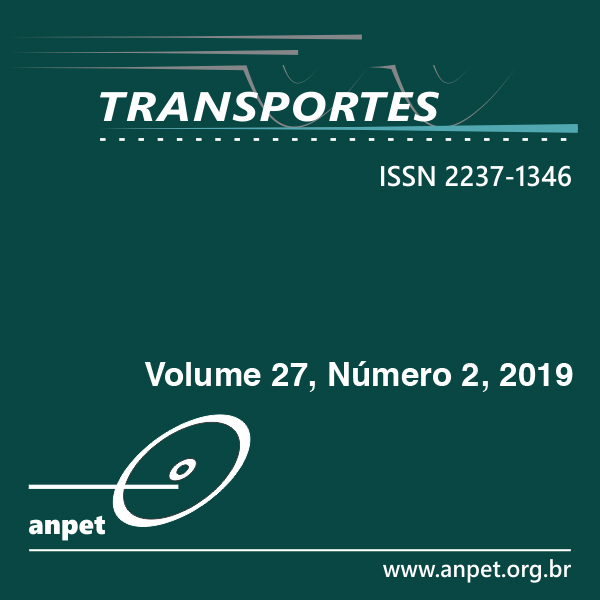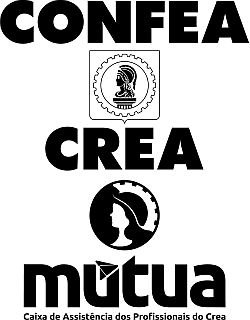Avaliação do potencial de integração entre o uso e ocupação do solo e o transporte de carga em um recorte urbano de São Paulo
DOI:
https://doi.org/10.14295/transportes.v27i2.1620Palavras-chave:
Transporte Urbano de Carga, Uso e Ocupação do Solo, Densidades Urbanas, Modelagem Urbana, Freturb.Resumo
O objetivo desse artigo é realizar uma avaliação integrada entre o transporte urbano de carga e o uso e ocupação do solo, por meio da aplicação do modelo Freturb em um recorte urbano na cidade de São Paulo. Os resultados indicaram haver interdependências entre os parâmetros do transporte urbano de carga (tipos de veículos comerciais, condições de carga e descarga e quantidades de movimentações) e do uso e ocupação do solo (perfil econômico, dimensões dos estabelecimentos alimentícios, número de empregos e de habitantes), revelando quais aspectos do transporte urbano da carga impactam diretamente no uso do espaço urbano e quais elementos do uso e ocupação do solo condicionam aspectos da logística e do tráfego urbano, em um contexto urbano brasileiro. Entende-se que as inter-relações demonstradas sejam fundamentais para aprimorar políticas urbanas relacionadas à mobilidade urbana e ao uso e ocupação do solo, ao fomentar o planejamento e a gestão intersetoriais e interdisciplinares em cidades brasileiras.
Downloads
Referências
Allen, J.; Anderson, S.; Browne, M.; Jones, P. (2000) A framework for considering policies to encourage sustainable urban freight traffic and goods/services flows. Transport Studies Group, University of Westminster, London, England. 4 volumes.
Ambrosini, C.; Gonzalez-Feliu, J.; Toilier, F. (2013) A design methodology for scenario-analysis in urban freight modelling. European Transport, v. 54, n. 7, p. 1-21.
Ambrosini, C.; Routhier, J. L. (2004) Objectives, Methods and Results of Survey Carried out in the Field of Urban Freight Transport: An International Comparison. Transport Reviews: A Transnational Transdisciplinary Journal, v. 24, n.1, p. 57-77. DOI: 10.1080/0144164032000122343
Beziat, A. (2013) French cities’ urban freight surveys. 1st Scientific and Technical Workshop, Bologna.
Boerkamps, J.; Binsbergen, A. V. (1999) Good Trip - A new approach for modelling and evaluation of urban goods distribution. In Taniguchi E., Thompson R.G. (eds.). City logistics I, Institute for City Logistics, Kyoto, p. 175-186.
Boerkamps, J.; Binsbergen, A. V.; Bovy, P. H. L. (2000) Modeling behavioral aspects of urban freight movement in supply chains. Transportation Research Record: Journal of the Transportation Research Board, v. 1725, n. 1, p. 17-25. DOI: 10.3141/1725-03
Bonnafous, A.; Gonzalez-Feliu, J.; Routhier, J. L. (2013) An alternative UGM paradigm to OD matrices: the FRETURB model. In: WCTR 2013 Rio de Janeiro, p. 21.
CET-SP - Companhia de Engenharia de Tráfego da Cidade de São Paulo. (2019). Mapa Zona Azul. A zona azul em números. Disponível em:http://www.cetsp.com.br/consultas/zona-azul/mapa-zona-azul/mapa-zona-azul.aspx. Acesso em: 14 fevereiro 2019.
Dablanc, L. (2008) Urban Goods Movement and Air Quality, Policy and Regulation Issues in European Cities. Journal of Environmental Law, v. 20, n. 2, p. 245-266, DOI: 10.1093/jel/eqn005
Dablanc, L.; Giuliano, G.; Holliday, K.; O’Brien, T. (2013) Best Practices in Urban Freight Management: Lessons from an International Survey. TRB, Transportation Research Record, v. 2379, n. 1, p. 29-38. DOI: 10.3141/2379-04
Dablanc, L.; Frémont, A. (2015) La métropole logistique. Le transport des marchandises et le territoire des grandes villes. Paris, Armand Colin, 312 p.
Delaître, L.; Routhier, J. L. (2010) Mixing two French tools for delivery areas scheme decision making. Procedia-Social and Behavioral Sciences, v. 2, n. 3, p. 6274-6285. DOI: 10.1016/j.sbspro.2010.04.037
Federal Highway Administration - FHWA (2012). FHWA freight and land use handbook. Washington, DC: US Department of Transportation.
IBGE - Instituto Brasileiro de Geografia e Estatística. (2010) Censo Demográfico 2010. Disponível em: http://www.ibge.gov.br/home/estatistica/populacao/censo2010/. Acesso em: 14 fevereiro 2019.
Lindholm, M.; Blinge, M. (2014). Assessing knowledge and awareness of the sustainable urban freight transport among Swedish local authority policy planners. Transport Policy, v. 32, p. 124–131. DOI: 10.1016/j.tranpol.2014.01.004
Marins, K. R. C. C.; Romero, M. A. (2012) Integração de condicionantes de morfologia urbana no desenvolvimento de metodologia para planejamento energético urbano. Ambiente Construído, Porto Alegre, v. 12, n. 4, p. 117-137. DOI: 10.1590/S1678-86212012000400009
Meimbresse, B.; Sonntag, H. (2001) Modelling urban commercial traffic with the model WIVER, In: Patier, D. (ed.) L’intégration des marchandises dans le système des déplacements urbains, p. 93-106, Lyon: Laboratoire d’Economie des Transports.
Rodrigue, J-P (2013) Urban Goods Transport. In: UNHABITAT Planning and Design for Sustainable Urban Mobility: Global Report on Human Settlements 2013, United Nations Human Settlements Programme, London: Earthscan.
Rodrigue, J-P.; Dablanc, L.; Giuliano, G. (2017) The freight landscape Convergence and divergence in urban freight distribution. Journal of Transport and Land Use, v. 10, n. 1, p. 557-572. DOI: 10.5198/jtlu.2017.869
Routhier, J. L.; Toilier, F. (2007) FRETURB V3, A Policy Oriented Software of Modelling Urban Goods Movement. 11th WCTR, Jun 2007, Berkeley, United States.
Routhier, J. L.; Toilier, F. (2013) Freturb V3.0 Diagnostic and Simulation Software for Urban Freight Transport. Laboratory of Economy of Transport, University of Lyon.
Russo, F., Comi, A. (2010) A classification of city logistics measures and connected impacts. Procedia–Social and Behavioral Sciences, v. 2, n. 3, p. 6355-6365. DOI: 10.1016/j.sbspro.2010.04.044
São Paulo (Cidade). Lei no.16.050, de 31 de julho de 2014. Política de Desenvolvimento Urbano e o Plano Diretor Estratégico. São Paulo: Diário Oficial da Cidade de São Paulo, 01 de agosto de 2014, ano 59, n. 140, p. 1-352.
São Paulo (Cidade) Secretaria Municipal de Urbanismo e Licenciamento. Dados Estatísticos. Disponível em:http://www.prefeitura.sp.gov.br/cidade/secretarias/desenvolvimento_urbano/dados_estatisticos/. Acesso em: 14 fevereiro 2019.
Silva, T. C. M.; Marins, K. R. C. C. (2014) Discutindo o papel do transporte de carga no planejamento urbano: contextualização e comparativo conceitual. In: XXVIII Congresso Nacional de Pesquisa e Ensino em Transporte da ANPET, 2014, Curitiba, Paraná.
Taniguchi, E.; Thompson, R. G.; Yamada, T. (2016) New opportunities and challenges for city logistics. Transportation Research Procedia, v. 12, p. 5-13. DOI: 10.1016/j.trpro.2016.02.004
Downloads
Publicado
Como Citar
Edição
Seção
Licença
Ao submeter um manuscrito para publicação neste periódico, todos os seus autores concordam, antecipada e irrestritamente, com os seguintes termos:
- Os autores mantém os direitos autorais e concedem à Transportes o direito de primeira publicação do manuscrito, sem nenhum ônus financeiro, e abrem mão de qualquer outra remuneração pela sua publicação pela ANPET.
- Ao ser publicado pela Transportes, o manuscrito fica automaticamente licenciado sob a Licença Creative Commons CC BY 4.0. Esta licença permite o seu compartilhamento com reconhecimento da autoria e da publicação inicial neste periódico.
- Os autores têm autorização para assumir contratos adicionais separadamente, para distribuição não exclusiva da versão do trabalho publicada neste periódico (por ex.: publicar em repositório institucional ou como capítulo de livro), com reconhecimento da publicação inicial na Transportes, desde que tal contrato não implique num endosso do conteúdo do manuscrito ou do novo veículo pela ANPET.
- Os autores têm permissão e são estimulados a publicar e distribuir seu manuscrito online (por ex.: em repositórios institucionais ou na sua página pessoal) depois de concluído o processo editorial. Como a Transportes é de acesso livre, os autores são estimulados a usar links para o DOI do artigo nesses casos.
- Os autores garantem ter obtido a devida autorização dos seus empregadores para a transferência dos direitos nos termos deste acordo, caso esses empregadores possuam algum direito autoral sobre o manuscrito. Além disso, os autores assumem toda e qualquer responsabilidade sobre possíveis infrações ao direito autoral desses empregadores, isentando a ANPET e a Transportes de toda e qualquer responsabilidade neste sentido.
- Os autores assumem toda responsabilidade sobre o conteúdo do manuscrito, incluindo as devidas e necessárias autorizações para divulgação de dados coletados e resultados obtidos, isentando a ANPET e a Transportes de toda e qualquer responsabilidade neste sentido.











